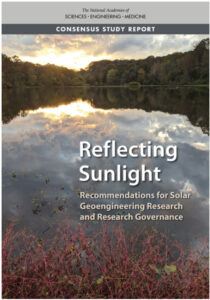(Image Description: McKay et al., Exceeding 1.5 C global warming could trigger multiple climate tipping points, Science, September 9, 2022. There are many other tipping systems defined in other works based on different criteria but these will do for illustration. Tipping science is still developing, this has never happened before and physical evidence is extremely rare. Therefor modeling must suffice and modeling is challenging at best. These data however, do reflect generally the current state of climate tipping systems from other works. Note how many systems tipping ranges begin at the maximum warmth of the Holocene at about 1 degrees C above normal. Note how the Amazon is not yet into its tipping range but we know that it is already emitting and not sequestering because of mortality from five, greater than 100-year droughts since 2020 – link to paper.)
Trust In Engineers
Only by including properly researched intervention “tourniquets” to our “bleeding” Earth can we start to pull back from brink of irreversible tipping. Our advanced civilization relies upon our engineers to keep us safe from danger, to treat pollution so we incur no harm, to design a world where we can live free from undue risk, literally, to geoengineer our world for the betterment of mankind. This geoengineering is all around us and has been for a 2,000 years. Everywhere one looks, engineers have changed Earth for the betterment of humankind. Geoengineering is not a problem as our engineers are trained to keep us safe. The problem is perceived fear of the unknown. If more people knew what geoengineering actually is and how long we have been practicing it and that it is responsible for humankind’s population advancing from 1 billion to 8 billion souls, engineered cooling solutions fear would not be an issue.
The Moral Hazard
A primary argument has been that, pursuing engineered cooling solutions constitutes a “moral hazard” because implementation might well slow GHG emissions reduction efforts and this would be “morally wrong.” Now that effects from warming are becoming repeatedly unprecedented, and that tipping elements have activated and they do not self-restore unless we cool our climate from today, and future emissions reductions cannot cool our climate at all in time frames that matter, and considering warming in the pipeline that even with complete emissions cessation that we continue to warm because of warming in the pipeline that our cool oceans and ice sheets (and aerosols) have been masking; the real “moral hazard” then, is the failure to pursue cooling approaches that can stop irreversible tipping responses, and reduce ecological and human disasters and costs. The moral hazard no longer lies in researching and deploying climate cooling approaches, but now in the failure to explore all feasible approaches to reduce near-term global warming.
Creating a Sustainable World With Temporary Engineered Cooling Solutions
Many of the climate cooling approaches are low-tech and can be responsibly deployed at local to regional scales with few, if any, potential risks and often, many co-benefits. Similarly, various of the global-scale approaches can be tested and implemented at low intensity using an “apply, evaluate, adjust” sequencing because their effects are readily reversible if unexpected, potentially deleterious consequences arise.
Learning by Doing – Ramping Up Engineered Cooling Solutions and Governance
World governance is a problem. There is none. Or, there is very little, yet it is implied that engineered cooling solutions are against international law. What guidelines there are goals and principles that are interpreted to be affected by engineered cooling solutions. For example, the Center for Biological Diversity (CBD) has goals that conserves biodiversity and resources, and shares the benefits of genetic resources. Specifically, changes in regional weather patterns could affect ecologies. Some interpret these goals as being negatively impacted by engineered cooling solutions. Maybe so, but does CBD consider the risk/risk analysis, or are they simply applying the moral hazard from days gone by?
Still, it may be possible to pilot-test and gradually deploy high-leverage engineered cooling strategies with great prospects like stratospheric aerosol injection (SAI). This is “learning by doing” and it can be done at a regional scale without global governance and coordination by following the Great Barrier Reef tropospheric aerosols example. SAI could be pilot tested with consent from affected communities and authorities in accordance with an international, voluntary and transparent “coalition of the willing” agreement. this learn by doing strategy starts with outdoor testing, evaluation and modification of the test to reduce or eliminate negative effects and enhance positive effects. The test are increased in size using the same iterative evaluation and modification process. The results is a full scale strategy in much faster time that traditional science certainty first procedures. Basically, what happens is that scientists turn the scientific knowledge over to engineers that then scale the strategy safely and efficiently. this is what engineers have been doing for 2,000 years. they keep us safe. they are trustworthy.
Emergency Implementation of Engineered Cooling Solutions
In some cases, sufficient authority to deploy an emergency cooling mechanism may already be in place. The International Maritime Organization (IMO) could, for example, address the unintended global warming produced by its well-intended maritime fuel sulfur regulations under its existing authority. First, the IMO could immediately adopt an emergency regulation relaxing 2015 and 2020 shipping fuel sulfur content restrictions in the high seas, to resume sulfate aerosol cooling except when within 200miles of land. Second, as a long-term solution, the IMO could support research and implement regulations requiring use of alternative fuels or power sources and the emission of aerosol precursors more benign than sulfates to human and environmental health, so as to replace the prior beneficial global cooling from burning sulfur. These measures alone could produce significant cooling and buy time to further implement more effective solutions using learning by doing.
Similarly, sulfur regulations in fossil fuels over land could be relaxed. this of course carries with it much higher risk of human and other mortalities, but these risks need to be balanced with the risks of not cooling with emergency urgency. the point of no return waits for none.
There are also new regulations for ultrafine particles when burning fossil fuels in vehicles. Particulate emissions standards in Europe and China in 2014 and 2017 and the US in 2024, sought to regulate ultra fine particulates (UFPs) that double to triple in particle count with gasoline direct injection engines. This direct injection technology is coming to dominate the market because of fuel efficiency but because some sulfur remains in fuels this direct injection technology creates a much bigger problem with aerosols. These emissions are so small, less than 0.1 micron where current regulations ( PM 2.5) regulate particles down to 2.5 microns, their mass is almost negligible and our present mass-based regulations on sulfur emissions no longer apply. The new regs are designed to limit the number of particulate particles instead of the mass of particles by using gasoline particle filters (GPFs). These new limits are likely and significantly reducing a new source of global cooling sulfate aerosols and thus revealing masked warming. Direct injection creates 1 to 2 times more particles less than 0.1 micron and herein lies the challenge: it is the number of particles that matter to both respiratory illness and global cooling. Smaller particles both cool more than larger particles, and penetrate more deeply into the lungs.
Once again, a risk/risk analysis would quite likely reveal that implementing engineered cooling solutions is a great deal compared to not implementing them because of the short time to the point of no return of tipping responses.
The Limits of Engineered Cooling Solutions
Even though engineered cooling solutions are the only way we can avoid natural feedback emissions that dwarf humankind’s from the irreversible point of no return of tipping elements, it would not be good luck to assume that we could continue these solutions forever, or even for much more than decades. Our oceans are probably the biggest reason, as increasing acidification is not mitigated by most engineered cooling strategies and ocean systems collapses would likely be of the most serious kind.
Delay in action to deploy engineered cooling solutions, like when we delayed action on reducing emissions, creates a world where even engineers cannot change our future. As an example, engineered cooling via reflective aerosols does nothing to reduce ocean acidity as the excess CO2 that caused the increased acidity remains. Our oceans are already on the brink of profound acidification that can create extinction level effects with primary productivity. There is great risks in allowing ocean acidity to not only continue, but to increase as it will with aerosol cooling.
Aerosol cooling, and many other types of engineered cooling solutions, also do not do well with high levels of CO2 in that, greater CO2 concentrations in our atmosphere tend to limit the formation of lower clouds allowing more sunlight to strike the Earth’s surface and be changed into heat. therefor the efficiency of many engineered solutions becomes less and less with greater atmospheric CO2 concentrations.
Conclusion
The road to climate stability and a sustainable planet will ultimately require a complete transformation of global industrial civilization’s economies, systems, and practices, but if we do not first cool, and do so in time frames relative to tipping processes, so as to eliminate untenable futures from tipping responses, all other actions to create a sustainable human culture will be for naught.
The following is a table to what are plausible, thirteen of the most promising cooling strategies from Baiman 2024 – Description of direct climate cooling (DCC) methods.



